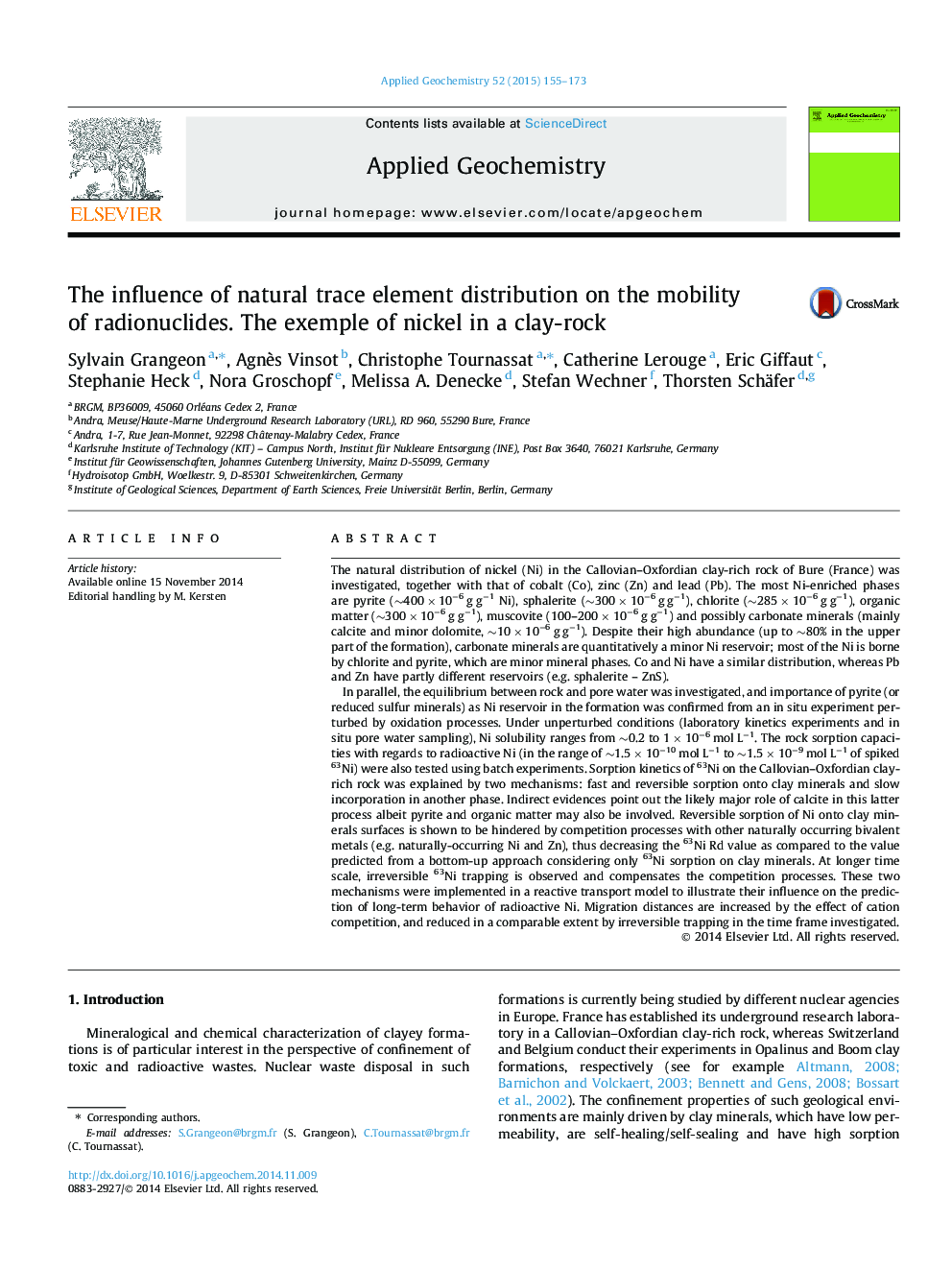| کد مقاله | کد نشریه | سال انتشار | مقاله انگلیسی | نسخه تمام متن |
|---|---|---|---|---|
| 4435724 | 1620239 | 2015 | 19 صفحه PDF | دانلود رایگان |
• Ni distribution in the Callovian–Oxfordian formation (Bure, France) was investigated.
• Ni is mainly borne by pyrite (Py), chlorite and organic matter (OM).
• 63Ni sorption on clays is hindered by competition with trace metals (e.g. Zn, Co).
• Additional sorption mechanisms are necessary to explain 63Ni long-term retention.
• These may be isotopic exchange and structural incorporation (into calcite, OM or Py).
The natural distribution of nickel (Ni) in the Callovian–Oxfordian clay-rich rock of Bure (France) was investigated, together with that of cobalt (Co), zinc (Zn) and lead (Pb). The most Ni-enriched phases are pyrite (∼400 × 10−6 g g−1 Ni), sphalerite (∼300 × 10−6 g g−1), chlorite (∼285 × 10−6 g g−1), organic matter (∼300 × 10−6 g g−1), muscovite (100–200 × 10−6 g g−1) and possibly carbonate minerals (mainly calcite and minor dolomite, ∼10 × 10−6 g g−1). Despite their high abundance (up to ∼80% in the upper part of the formation), carbonate minerals are quantitatively a minor Ni reservoir; most of the Ni is borne by chlorite and pyrite, which are minor mineral phases. Co and Ni have a similar distribution, whereas Pb and Zn have partly different reservoirs (e.g. sphalerite – ZnS).In parallel, the equilibrium between rock and pore water was investigated, and importance of pyrite (or reduced sulfur minerals) as Ni reservoir in the formation was confirmed from an in situ experiment perturbed by oxidation processes. Under unperturbed conditions (laboratory kinetics experiments and in situ pore water sampling), Ni solubility ranges from ∼0.2 to 1 × 10−6 mol L−1. The rock sorption capacities with regards to radioactive Ni (in the range of ∼1.5 × 10−10 mol L−1 to ∼1.5 × 10−9 mol L−1 of spiked 63Ni) were also tested using batch experiments. Sorption kinetics of 63Ni on the Callovian–Oxfordian clay-rich rock was explained by two mechanisms: fast and reversible sorption onto clay minerals and slow incorporation in another phase. Indirect evidences point out the likely major role of calcite in this latter process albeit pyrite and organic matter may also be involved. Reversible sorption of Ni onto clay minerals surfaces is shown to be hindered by competition processes with other naturally occurring bivalent metals (e.g. naturally-occurring Ni and Zn), thus decreasing the 63Ni Rd value as compared to the value predicted from a bottom-up approach considering only 63Ni sorption on clay minerals. At longer time scale, irreversible 63Ni trapping is observed and compensates the competition processes. These two mechanisms were implemented in a reactive transport model to illustrate their influence on the prediction of long-term behavior of radioactive Ni. Migration distances are increased by the effect of cation competition, and reduced in a comparable extent by irreversible trapping in the time frame investigated.
Journal: Applied Geochemistry - Volume 52, January 2015, Pages 155–173
